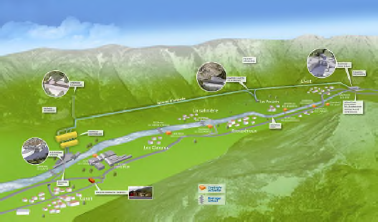
Association registered under the 1901 Act (non profit) with 817 members. AFTES established in 1972, aims to associate, with an ongoing commitment, owners, engineering firms, research and training centers and contractors.
Mobilize our industry in order to share and develop our common knowledge, keep informed and support all stakeholders in technical, contractual, social, environmental matters. Promote the use of Underground Space and support all actions to make it known. Improve visibility of AFTES’ actions and works including its national and international influence. Help enlarging the know-how of French engineering and contracting firms. Keep developing technical input and doctrine elaboration, in line with key needs of our members and including even higher technical intelligence. Attract and involve more young people in AFTES and in the underground business.
Education committee
Post-graduate specialized Master ‘degree‘ Tunnels and underground structures from design to operation’
The “Tunnels and underground structures” Master’s programme, started in 2011, is designed to provide generalist civil engineers with a year-long postgraduate course in tunnels and underground structures that will give students the skills to rapidly rise to management positions in construction companies, project management firms, and client and contractor structures.
Classes and project tutoring make considerable use of French and foreign teachers and experts work in the profession.
Public training
In 2012, 10 public conferences were held:
- The behavior of structures submitted to fire in road and railway tunnels
- The measures for auto-evacuation planned in Ile-de-France
- Foreign approaches of safety in underground spaces
- Compared approaches of safety in underground spaces
- Channel Tunnel: Organization of the supervision and maintenance
- Asset management of RFF tunnels
- The various plans of realization of a project and the responsibilities of the actors in the French regulatory framework
- The types of the most common contracts abroad and their peculiarities related to underground works
- Immersed Tunnels
- Integration of the underground space in the city, why and how?
Underground space committee
Among the actions led by the Underground Space Committee, the National Research Project Ville10D occupies a privileged position. It establishes a mean to accelerate the production of doctrine, to communicate, and to mobilize resources on the questions of the underground use.
The total budget of the Project is about 5,2 million euros taking into account the totality of contributions valued by all the partner participants. The contribution in financing is about 2 million euros of which a million euros of State subsidies.
A major stage of the National Project was reached on November 30th, 2012, with the launching general assembly. The first working tasks will start on January 1st, 2013.
Technical Committee
23 active working groups in 2012. Two groups were reactivated: Ventilation during the construction works (GT27) and Management and valuation of the extracted materials (GT 35), whereas a new group has been created: Radioactive rocks (GT 42).
These groups work on different paces but this remains a continuous and a very important activity for the AFTES. 320 active members of these groups are voluntary specialists.
In 2012, two recommendations were published: the GT 32 on the characterization of geotechnical hazards and risks; the second relates the difficulties in the construction of linings (GT 36).
Large hydraulic project for EDF for the valley of the Romanche.
 Works located in the municipality of LIVET and GAVET in the department of Isère ( 38 ). Starting of works in July, 2011 - End of works 2017.
Works located in the municipality of LIVET and GAVET in the department of Isère ( 38 ). Starting of works in July, 2011 - End of works 2017.
Investment approx. 250 MioE.
Total quantity extracted materials: 310 000 m3.
Estimated total concrete quantity: 30 000 m3.
Diameter of the gallery: 4,7 m.
Length of the gallery: 9,3 km - Digging of the gallery by 2 TBM of 100 m length, 4,7 m diameter and a power of 2 MW.
Height of surge shaft: 180 m.
Size of the power plant: L 74 m x l 16 m x h 35 m - 2 turbines and energy dissipaters made of 4 Hydraulic gates (maximal power of 92 MW).
Potential annual production of 560 million kWh / year (for a city of more than 220 000 inhabitants).
Evacuation of the energy through the 63 000 V network.

